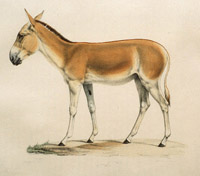Institut für Biologie der Martin-Luther-Universität Halle-Wittenberg
Date of this Version
2010
Document Type
Article
Citation
Erforschung biologischer Ressourcen der Mongolei (2010) 11: 189-212.
Abstract
In 1994, 1995, 1997, 1998, and 2000, I led small teams of biologists across Mongolia in search of Saker falcon (Falco cherrug Gray) and golden eagle (Aquila chrysaetos) eyries. We also counted raptors along our march route during the first three years. These expeditions documented: (1) occupancy and productivity rates, and described eyrie sites, for Saker falcons (150 territories, 182 eyries) and golden eagles (27 known breeding territories), (2) mortality of Sakers and ipland buzzards (Buteo hemilasius) due to entanglement with trash in nests and loss of golden eagle eggs due to concealment by trash in nests, (3) long-distance movements of an adult steppe eagle (Aquila nipalensis) and one young monk vulture (Aegypius monachus) via satellite telemetry, (4) occurrence of gyrfalcon-like Sakers at many locations across Mongolia, (5) extensive variation in leg and foot feathering in the upland buzzard that probably is evidence that this species is the result of hybridization, (6) extensive use by Sakers of powerline support structures for nesting (7) Saker ground nesting, nesting on boulders, in attics, on buildings, and on many other novel supports, (8) use of paper money in golden eagle and upland buzzard nests as nesting materials, (9) the first observation of siblicide for falcons (Sakers) and a new falcon social display (splayed-toes-flight), also for the Saker, (10) extensive predation on mammalian and avian predators by the Golden Eagle, (11) breeding by pale steppe eagles, and (12) relatedness of Mongolian Sakers to other Saker and gyrfalcon (Falco rusticolus) demes. In response to the propensity of Mongolian Sakers to nest on artificial structures, and from an apparent population limiting lack of suitable breeding sites, we began in 1997 to create artificial eyries for Sakers, with 150 built by 2000.
Included in
Asian Studies Commons, Biodiversity Commons, Desert Ecology Commons, Environmental Sciences Commons, Nature and Society Relations Commons, Ornithology Commons, Other Animal Sciences Commons


Comments
Copyright 2010, Martin-Luther-Universität Halle Wittenberg, Halle (Saale). Used by permission.